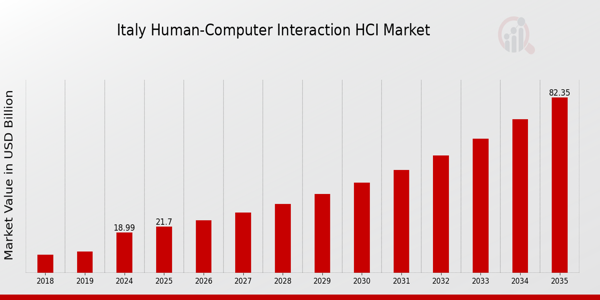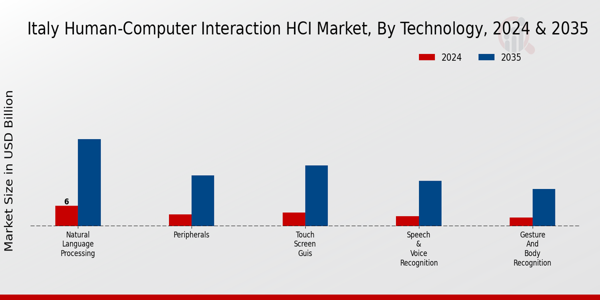Italy Human-Computer Interaction (HCI) Market Overview
As per MRFR analysis, the Italy Human-Computer Interaction (HCI) Market Size was estimated at 17.14 (USD Billion) in 2023. The Italy Human-Computer Interaction (HCI) Market Industry is expected to grow from 18.99(USD Billion) in 2024 to 82.35 (USD Billion) by 2035. The Italy Human-Computer Interaction (HCI) Market CAGR (growth rate) is expected to be around 14.267% during the forecast period (2025 - 2035)
Key Italy Human-Computer Interaction (HCI) Market Trends Highlighted
Technology breakthroughs and a rise in customer demand for user-centered designs are driving major trends in the Italian human-computer interaction (HCI) sector. One of the main factors propelling the market is the growing use of AI and machine learning in a variety of applications. Italian businesses are making significant investments in smart technology to improve user experiences across devices and develop user-friendly interfaces. The increasing emphasis on accessibility in design is particularly crucial because laws promote the creation of goods that can serve consumers with a range of demands, opening the door for inclusive design techniques.
Opportunities for HCI to close the gap between users and technology are opening up in fields like healthcare and education. Innovative solutions that enhance interaction and engagement are becoming more and more in demand as telemedicine and e-learning continue to expand. Additionally, the thriving Italian startup scene encourages innovation in creating HCI solutions that serve both domestic and international markets. Collaborations between tech businesses and universities to innovate in HCI research and product development are made possible by this environment. Natural user interfaces (NUIs) have gained popularity in Italy in recent years.
These touch, speech, and gesture-based interfaces show a change in how people engage with technology.
Traditional user experiences are being transformed by the growing usage of augmented and virtual reality, particularly in industries like training simulations and gaming. The Italian government's backing of digital transformation projects shows that it is dedicated to developing HCI technologies and encourages companies to look for new growth and development opportunities in this dynamic sector.

Source: Primary Research, Secondary Research, Market Research Future Database and Analyst Review
Italy Human-Computer Interaction (HCI) Market Drivers
Increasing Adoption of Smart Devices
The growth in the Italy Human-Computer Interaction (HCI) Market Industry is significantly driven by the increasing adoption of smart devices such as smartphones, tablets, and smart home technologies. According to the Italian National Institute of Statistics, there has been a steady rise in smartphone usage, with approximately 76% of Italians owning a smartphone as of 2022.
This increased accessibility to smart devices necessitates improvements in HCI technologies to enhance user experiences, control interfaces, and intuitive interactions.Companies like Google and Apple are continually investing in Italy, focusing on advancing user interface designs that cater to the growing number of smart device users. Such advancements are projected to significantly propel the HCI market forward as users demand more seamless interactions with their devices.
Growing Importance of Digital Transformation
The ongoing digital transformation across various sectors in Italy is a major growth driver for the Italy Human-Computer Interaction (HCI) Market Industry. The Italian government is committed to enhancing digital infrastructure, with the National Recovery and Resilience Plan allocating around €50 billion for digitalization initiatives. As businesses and public services digitize, there is a heightened need for effective human-computer interaction solutions to streamline operations and enhance user engagement.
For instance, major organizations such as Telecom Italia are investing in HCI to improve customer service interfaces and digital platforms. Consequently, this shift towards digitalization is expected to further cement the demand for innovative HCI technologies in Italy.
Rising Demand for Enhanced User Experience
The focus on user experience has increasingly become a critical aspect of technology adoption in Italy, providing a significant impetus for the Italy Human-Computer Interaction (HCI) Market Industry. A survey conducted by the Digital Innovation Hub revealed that 83% of Italian users prioritize user-friendliness in applications and websites. This paradigm shift emphasizes the need for companies to integrate HCI principles to ensure that products meet customer expectations.
Organizations like Eni and Fiat Chrysler Automobiles are incorporating user-centric design processes into their digital offerings, highlighting the essential requirement for innovative HCI solutions that enhance usability. This trend directly correlates with increased investment in user experience research and design, propelling market growth.
Advancements in Artificial Intelligence and Machine Learning
The integration of Artificial Intelligence (AI) and Machine Learning (ML) technologies into HCI systems is a significant driver of growth for the Italy Human-Computer Interaction (HCI) Market Industry. With Italy being a hub for technological innovation, companies are increasingly leveraging AI to create more interactive and intelligent interfaces. Research from the Italian Institute of Technology reveals a 35% increase in AI-related projects over the last two years, reflecting a surge in available solutions that enhance user interactions.
Major firms like Olivetti are at the forefront of developing AI-driven HCI applications that can learn from user behavior, thereby tailoring experiences to individual needs. This trend is expected to catalyze advancements in HCI, addressing complex user requirements and improving overall satisfaction.
Italy Human-Computer Interaction (HCI) Market Segment Insights
Human-Computer Interaction (HCI) Market Technology Insights
The Technology segment within the Italy Human-Computer Interaction (HCI) Market is experiencing notable advancements and diversification, with a clear trajectory of growth fueled by evolving consumer demands and technological innovation. This sector encompasses various forms of interaction devices and interfaces that facilitate communication between users and computers, enhancing user experience and accessibility across multiple platforms. Peripheral devices, which include a variety of input and output tools, serve as critical mediators in this landscape as they bridge the gap between human intent and computer response, making them essential in both personal and professional environments.
Touch Screen Graphical User Interfaces (GUIs) have transformed engagement by allowing more intuitive and direct interaction, a trend prominently reflected in Italy's increasing adoption of smart devices in educational and corporate settings. Gesture and Body Recognition technologies are becoming significant as they offer users hands-free interaction, a feature that is becoming particularly essential in domains like gaming, healthcare, and virtual reality applications, enhancing immersion and usability.
Similarly, Speech and Voice Recognition technologies are gaining traction, responding to an escalating need for natural language interfaces that simplify command execution across devices; this trend aligns with Italy’s focus on user-centric design. Natural Language Processing continues to advance in capacity, allowing machines to understand and interpret human languages, thereby streamlining processes in customer service and translation services, which is invaluable for Italy’s vibrant tourism and service industries. The Brain-Computer Interface (BCI) segment is particularly intriguing, providing innovative solutions for aiding disabled individuals, a demographic that is gaining increased attention in Italy as accessibility becomes a forefront issue.
Eye Tracking technology contributes valuable insights into consumer behavior, particularly in the retail space, guiding design decisions based on genuine user interaction, and is steadily leading to improved marketing strategies among Italian retailers. Overall, the Technology segment within the Italy Human-Computer Interaction (HCI) Market is characterized by a fusion of utility and innovation, reflecting broader market trends aimed at enhancing user experience, accessibility, and engagement across various industries.
As technology continues to evolve, this segment is expected to play a pivotal role in shaping how users interact with digital environments in Italy, contributing to the overall market growth in the coming years.

Source: Primary Research, Secondary Research, Market Research Future Database and Analyst Review
Human-Computer Interaction (HCI) Market Organization Size Insights
The Italy Human-Computer Interaction (HCI) Market showcases a distinct division by Organization Size, primarily categorized into Small and Medium Enterprises (SMEs) and Large Enterprises. This segmentation reflects the varying adoption rates and needs of different organizational scales. SMEs often leverage user-friendly HCI solutions to enhance operational efficiency and improve customer interaction, driven by a rapid shift towards digital interfaces to meet consumer demands.
These organizations play a vital role in the proliferation of innovative HCI applications due to their agility and smaller decision-making structures.Conversely, Large Enterprises typically engage in more complex HCI implementations, focusing on advanced analytics and integrated systems that enhance user experience across vast operational frameworks.
The growth within this segment is influenced by Italy's technological advancements and a push for digital transformation across sectors, aligning with broader trends in the market. A substantial portion of market activity revolves around both segments, as they each contribute uniquely to the overall ecosystem of the Italy Human-Computer Interaction (HCI) Market, presenting opportunities and challenges pertinent to their respective sizes and capabilities.This diverse landscape encourages competition and innovation, fostering a dynamic environment for the future of HCI solutions in Italy.
Human-Computer Interaction (HCI) Market Component Insights
The Component segment of the Italy Human-Computer Interaction (HCI) Market plays a pivotal role in shaping the overall landscape of interactions between users and technology. This segment encompasses three main areas: Hardware, Software, and Services, each contributing significantly to the market's dynamism and growth. Hardware solutions are foundational, including devices such as input tools, displays, and sensors, which are critical for providing effective user experiences.
Software innovations facilitate complex interactions and are essential for developing user-friendly interfaces that cater to a diverse range of applications, from personal computing to mobile devices.Services complement these components by offering support, integration, and customization, thereby enhancing the efficacy of HCI implementations.
The growing adoption of Internet of Things (IoT) devices and smart technologies within Italy has driven increased investments in these areas, allowing for smoother interaction designs and improved functionalities. The market also faces challenges such as ensuring data security and the risk of obsolescence, but these hurdles present opportunities for innovative solutions and advancements in the HCI sector.With a focus on user-centered design, the Component segment will continue to evolve, meeting the demands of a rapidly changing technological landscape while benefiting from Italy's robust technological growth and digital transformation initiatives.
Human-Computer Interaction (HCI) Market Application Area Insights
The Italy Human-Computer Interaction (HCI) Market focuses significantly on the Application Area, capturing a diverse range of sectors contributing to the market's evolution. The healthcare sector is revolutionized by HCI technologies, enhancing patient care and streamlining operations, which is increasingly critical in Italy's aging population context. In the realm of Personal Computers and Smartphones, intuitive interfaces and user-friendly designs facilitate widespread engagement, bolstering productivity across professions. Gaming and Entertainment have been transformed by immersive experiences, encouraging social interactivity and providing economic benefits through increased consumer spending.
The Smart Home and White Goods segment showcases the demand for home automation, with consumers increasingly seeking convenience and energy efficiency, reflecting a shift in lifestyle. Wearables continue to gain traction as users prioritize health monitoring and connectivity, indicating a strong market presence. Education applications benefit from HCI by making learning more interactive and accessible, which is crucial for Italy’s educational reform initiatives. The Automotive sector leverages HCI to enhance driver experience and safety, making significant strides towards smarter transportation.Lastly, the Industrial segment uses HCI to improve operational efficiency, illustrating the vital role these technologies play in modern business practices.
Overall, the diverse applications within the Italy Human-Computer Interaction (HCI) Market signify its expansive growth and potential across various sectors.
Italy Human-Computer Interaction (HCI) Market Key Players and Competitive Insights
The competitive landscape of the Italy Human-Computer Interaction (HCI) market is rapidly evolving as technology continues to advance and integrate into everyday life. Increasing demand for intuitive and user-friendly interfaces has prompted a surge in innovation and competition among key players in the region. Analyzing the dynamics of this market reveals various strengths and strategies employed by companies to capture market share. With a robust emphasis on research and development, firms in Italy are exploring groundbreaking methods to enhance user experience, integrating artificial intelligence and machine learning to optimize interactions between humans and machines.
This competitive environment not only fosters innovation but also drives partnerships and collaborations, making the market an exciting arena for emerging trends and solutions.Qualcomm stands out in the Italy Human-Computer Interaction (HCI) market, leveraging its technological expertise to deliver advanced systems and components necessary for seamless human-device interaction. Its strong presence is bolstered by a diverse portfolio that includes cutting-edge semiconductors and integrated circuits, which are essential in powering a range of HCI applications. Qualcomm's strengths lie in its ability to combine performance with efficiency, allowing devices to operate smoothly while enhancing the user experience.
Furthermore, through continuous investment in R&D, Qualcomm is positioned to respond adeptly to changing market demands and consumer expectations, ensuring that its innovations remain relevant and ahead of the competition in Italy’s HCI sector.
SAP, with its robust enterprise solutions, also plays a significant role in the Italy Human-Computer Interaction (HCI) market. The company specializes in software that enhances user interfaces across various business applications, emphasizing seamless connectivity and data integration. Key products and services offered by SAP include enterprise resource planning systems that facilitate user engagement through intuitive design and user-friendly interactions. In Italy, SAP has established a strong foothold, catering to a wide array of industries while continuously enhancing its offerings. The company's strengths revolve around its solid reputation in software innovation and effective customer service.
Additionally, SAP has been involved in strategic mergers and acquisitions that enhance their capabilities in HCI, allowing them to expand their service range and bolster market presence in the region. This ongoing commitment to improvement makes SAP a formidable player in driving forward the HCI solutions landscape in Italy.
Key Companies in the Italy Human-Computer Interaction (HCI) Market Include
- Qualcomm
- SAP
- Cisco
- Hewlett Packard Enterprise
- Fujitsu
- Accenture
- Intuit
- Nokia
- Siemens
- Atos
- Adobe
- Google
- Microsoft
- Oracle
- IBM
Italy Human-Computer Interaction (HCI) Market Industry Developments
The Italy Human-Computer Interaction (HCI) Market has recently seen significant developments. In October 2023, SAP announced the launch of a new initiative focused on improving user interface design, positioning itself as a leader in the digital transformation space. Meanwhile, Cisco introduced advanced collaboration tools aimed at fostering remote work environments, which have gained traction in the Italian market. In terms of acquisitions, Fujitsu acquired a leading Italian software firm in September 2023, enhancing its portfolio in HCI solutions, while Microsoft's acquisition of a small Italian HCI startup in August 2023 bolstered its capabilities in developing user-friendly interfaces.
Major companies such as Accenture and IBM have also increased investments in HCI research, indicating a push towards innovative solutions. The growth of the HCI market in Italy is further supported by the government's focus on digitalization and technology integration across various sectors. Valuations for companies engaged in HCI have shown upward trends, reflecting increased demand for intuitive and efficient user experiences. Over the past two to three years, initiatives to improve technology accessibility have strengthened the HCI landscape in Italy, fostering growth and innovation.
Italy Human-Computer Interaction (HCI) Market Segmentation Insights
Human-Computer Interaction (HCI) Market Technology Outlook
- Peripherals
- Touch Screen GUIs
- Gesture and Body Recognition
- Speech & Voice Recognition
- Natural Language Processing
- Brain Computer Interface
- Eye Tracking
Human-Computer Interaction (HCI) Market Organization Size Outlook
Human-Computer Interaction (HCI) Market Component Outlook
- Hardware
- Software
- Services
Human-Computer Interaction (HCI) Market Application Area Outlook
- Healthcare
- Personal Computers & Smartphones
- Gaming & Entertainment
- Smart Home & White Goods
- Wearables
- Education
- Automotive
- Industrial
| Report Attribute/Metric Source: |
Details |
| MARKET SIZE 2023 |
17.14(USD Billion) |
| MARKET SIZE 2024 |
18.99(USD Billion) |
| MARKET SIZE 2035 |
82.35(USD Billion) |
| COMPOUND ANNUAL GROWTH RATE (CAGR) |
14.267% (2025 - 2035) |
| REPORT COVERAGE |
Revenue Forecast, Competitive Landscape, Growth Factors, and Trends |
| BASE YEAR |
2024 |
| MARKET FORECAST PERIOD |
2025 - 2035 |
| HISTORICAL DATA |
2019 - 2024 |
| MARKET FORECAST UNITS |
USD Billion |
| KEY COMPANIES PROFILED |
Qualcomm, SAP, Cisco, Hewlett Packard Enterprise, Fujitsu, Accenture, Intuit, Nokia, Siemens, Atos, Adobe, Google, Microsoft, Oracle, IBM |
| SEGMENTS COVERED |
Technology, Organization Size, Component, Application Area |
| KEY MARKET OPPORTUNITIES |
Voice-activated interfaces development, AR/VR technology integration, AI-driven user experience design, Remote collaboration tools enhancement, Accessibility solutions for disabled users |
| KEY MARKET DYNAMICS |
User experience emphasis, Advances in AI technology, Growth in remote work, Increased mobile device usage, Demand for accessibility solutions |
| COUNTRIES COVERED |
Italy |
Frequently Asked Questions (FAQ):
The Italy Human-Computer Interaction HCI Market is expected to be valued at 18.99 USD billion in 2024.
The market is projected to reach a value of 82.35 USD billion by 2035.
The expected CAGR for the Italy Human-Computer Interaction HCI Market is 14.267% from 2025 to 2035.
By 2035, the Natural Language Processing segment is projected to reach 25.85 USD billion, making it a dominant segment.
The Speech & Voice Recognition segment is expected to be valued at 3.0 USD billion in 2024.
Key players in the market include Qualcomm, SAP, Cisco, Hewlett Packard Enterprise, and Fujitsu, among others.
The market value for Peripherals is anticipated to reach 15.0 USD billion by 2035.
The growth is driven by increasing demand for user-friendly technology and advancements in interface design.
Primary applications include innovative user interfaces, virtual reality, and enhanced user experience across devices.
The expected growth rate for the Italy Human-Computer Interaction HCI Market is competitive, with a CAGR of 14.267% between 2025 and 2035.
















